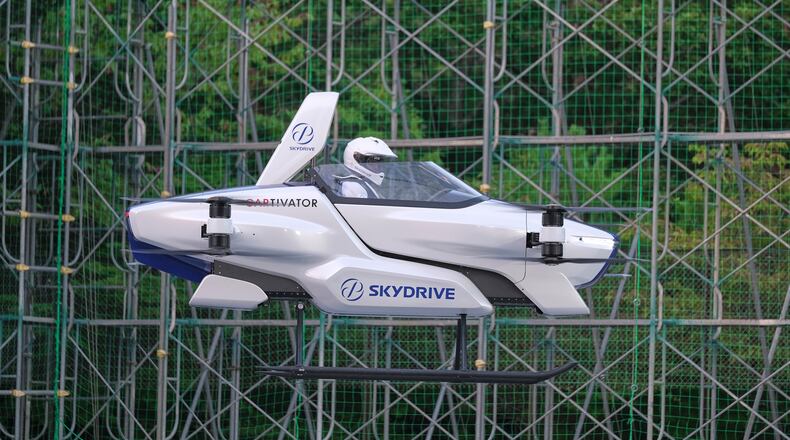Zooming through the sky in a flying car has always been the stuff of science fiction, but who would have predicted the feat to become reality in 2020?
Nearly 117 years after the Wright brothers made their first sustained flight of a powered aircraft in 1903, Japan’s SkyDrive Inc. last week unveiled its new flying machine — a single-passenger craft that looks a lot like a motorcycle with propellers.
Last week during a public test, the SD-03 — the world’s smallest electric vertical takeoff and landing vehicle — ascended several feet, hovered above ground in a netted area, then circled a field for four minutes, The Associated Press reported.
SkyDrive is just one of myriad projects around the world in the race to build the first successful flying car, according to the AP. Lilium of Germany, Joby Aviation in California and Wisk, a joint venture between Boeing Co. and Kitty Hawk Corp., are also working on eVTOL projects.
Tomohiro Fukuzawa, who heads SkyDrive, said he hopes “the flying car” can be made into a real-life product by 2023, but he acknowledged that safety was a critical concern in the early going.
“Of the world’s more than 100 flying car projects, only a handful has succeeded with a person on board,” he told the AP. “I hope many people will want to ride it and feel safe.”
For now, SkyDrive’s machine can stay in the air for only five to 10 minutes, but engineers are aiming for 30 minutes or more of air time as a benchmark, Fukuzawa said.
Known as eVTOL, or “electric vertical takeoff and landing,” flying vehicles would fly automatically and offer quickie personal travel to and from places not accessible by plane or helicopter, alleviating travel hangups such as long lines at airports and big-city traffic jams.
The Japanese government is reportedly bullish on “the Jetsons” vision, with a “road map” for business services by 2023 and expanded commercial use by the 2030s, stressing its potential for connecting remote areas and providing lifelines in disasters.
But drivers should not run out to get a pilot’s license just yet.
There are many potential challenges to commercializing the flying vehicles, including battery sizes, air traffic control and other infrastructure issues, not to mention an expensive price tag.
“Many things have to happen,” said Sanjiv Singh, professor at the Robotics Institute at Carnegie Mellon University, who co-founded Near Earth Autonomy, near Pittsburgh, which is also working on an eVTOL aircraft. “If they cost $10 million, no one is going to buy them. If they fly for five minutes, no one is going to buy them. If they fall out of the sky every so often, no one is going to buy them,” Singh told the AP.
SkyDrive began in 2012 as a volunteer effort called Cartivator, with funding from top Japanese companies including automaker Toyota Motor Corp., electronics giant Panasonic Corp. and video game developer Bandai Namco.
The craft’s performance has improved since a demonstration flight three years ago flopped. As a result, the project recently received the equivalent of $37 million in funding, with the Development Bank of Japan also pitching in.
— Information provided by The Associated Press was used to supplement this report.
About the Author
The Latest
Featured


